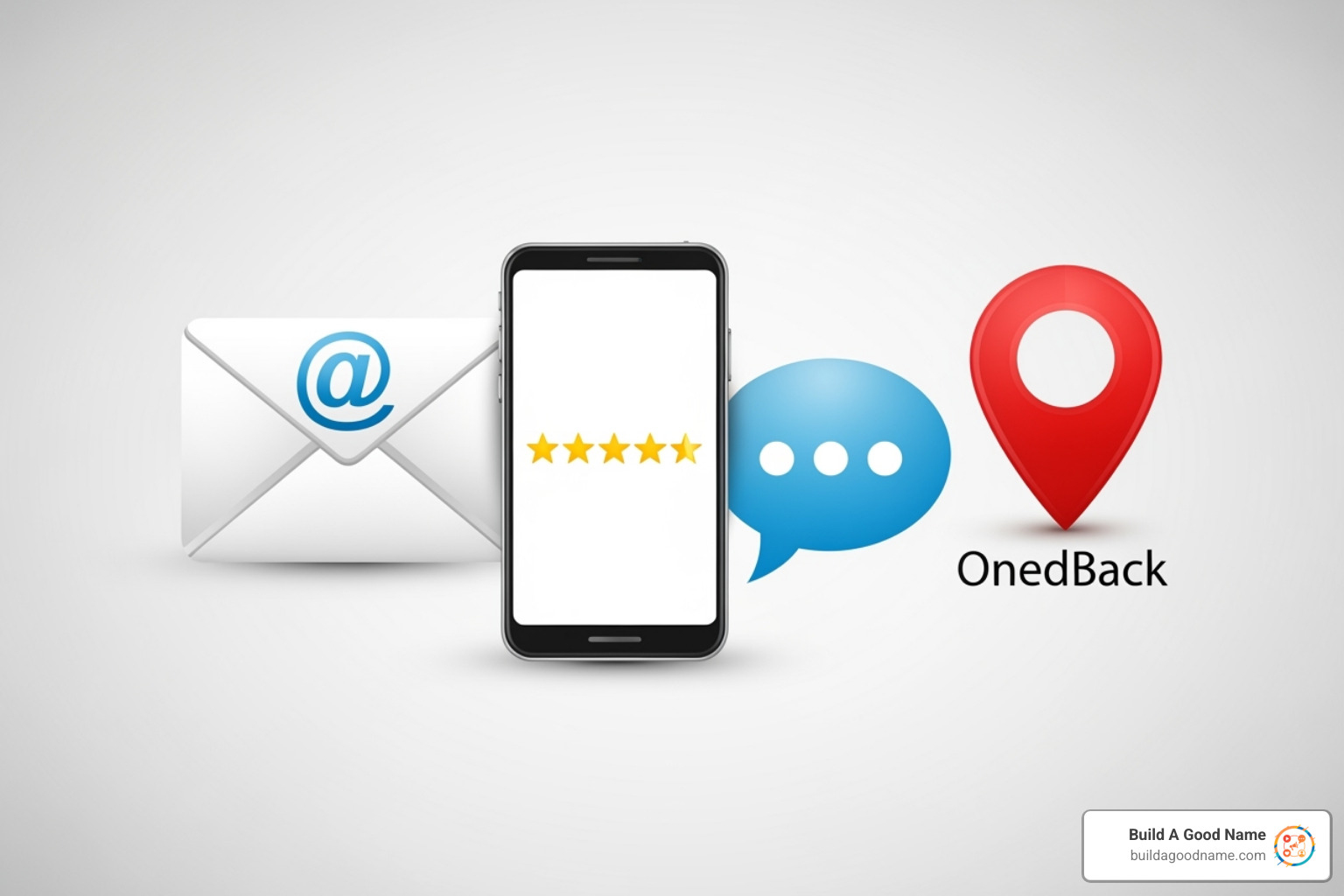Why Your Next Customer is Reading Your Last Customer’s Review
When you collect customer reviews, you transform your business. The numbers are clear: displaying testimonials can increase conversion rates by 270%, and 84% of consumers trust online reviews as much as personal recommendations. Your potential customers are already looking for social proof. The only question is whether they’ll find glowing testimonials or silence.
Quick Methods to Collect Customer Reviews:
- Email campaigns – Send post-purchase review requests.
- SMS follow-ups – Use quick, direct messages with review links.
- Website integration – Add “Leave a Review” pages and pop-ups.
- In-person asks – Train staff to request reviews after positive interactions.
- QR codes – Place them on receipts, business cards, and marketing materials.
- Review platform links – Direct customers to Google, Yelp, or Facebook.
Think about your own buying habits. You check reviews before choosing a restaurant or a plumber. Those stars and comments are decisive. Yet, many businesses passively wait for reviews, which is like planting a garden and forgetting to water it. The most successful companies are systematic. They make review collection a natural part of their process, turning every satisfied customer into a marketing asset without being pushy.

Quick Collect customer reviews terms:
The Undeniable Power of Customer Reviews
Customer reviews are often more powerful than your best salesperson. They provide unbiased proof that you deliver on your promises. When a customer shares their positive experience, it resonates more deeply with prospects than any marketing claim.
The numbers back this up. Displaying customer testimonials can increase conversion rates by 270%, and 84% of consumers trust online reviews as much as personal recommendations. When you systematically collect customer reviews, you build an army of advocates. For local businesses, the impact is direct: a 1-star increase in Yelp rating leads to a 5-9% revenue increase. With 98% of consumers reading online reviews for local businesses, your online reputation is your new storefront.
How Reviews Impact Your SEO and Online Reputation
Customer reviews significantly boost your online visibility. They contribute about 15.44% to Google’s local ranking factors, helping you appear in the coveted Local Pack. The star ratings in search results are conversion magnets, increasing click-through rates by up to 35%.
Each review adds fresh, user-generated content to your online presence, using the same keywords potential customers search for. This builds your E-E-A-T (Experience, Expertise, Authoritativeness, and Trustworthiness) in Google’s eyes. To learn more, see our guide on how to Boost Your Google Reviews and Your Ego Simultaneously.
The Psychology of Social Proof: Why Reviews Work
Reviews are powerful because of social psychology. Humans look to others for guidance, a phenomenon known as the bandwagon effect. Positive reviews act as powerful trust signals, reducing purchase anxiety for new customers.
They also tap into confirmation bias in purchasing decisions. When a potential customer is leaning toward your business, good reviews reinforce their choice. Reviews have become the digital equivalent of personal recommendations. When you consistently collect customer reviews, you build a community around your brand, turning customers into advocates.
5 Proven Channels to Collect Customer Reviews
Changing satisfied customers into your best marketing team requires a smart, multi-channel strategy. Instead of hoping reviews appear, meet your customers where they are.

Your customers interact with you at different moments and through various channels. To consistently collect customer reviews, you must tap into all these touchpoints. The key is to time your ask perfectly—right after a great experience, while the positive feeling is still strong.
Automation is your secret weapon. It allows you to set up systems that handle the follow-up, ensuring more reviews with less effort. A multi-channel approach means that if a customer misses an email, they might see a website pop-up or respond to a text. Each channel is another opportunity to capture a glowing review.
Let’s explore five channels that deliver consistent results.
1. Email: The Direct and Personal Approach
Email offers a direct line to your customers, with 91% of consumers opening their email daily. This captive audience is perfect for review requests. The power of email lies in its personal touch; you can craft messages that land directly in their inbox.
Timing is everything. The sweet spot is right after a customer has experienced your product or service. Post-purchase emails are highly effective because they catch people when they’re most likely to share positive feedback.
Automation and personalization are key. With Customer Review Automation, you can set up campaigns that trigger automatically after a transaction. Keep your emails clear and simple with a direct call-to-action link to your preferred review platform. Make it easy to leave a review in just a few clicks.
Your subject line is critical. Here are some proven options:
- “We’d Love Your Feedback!”
- “How Was Your Experience with Us?”
- “Quick Question: Share Your Thoughts!”
- “Got a Minute? Leave Us a Review!”
2. SMS: The Quick and Convenient Nudge
For instant reach, text messages are your secret weapon. With near-100% open rates, SMS messages are opened within minutes, ensuring your review request is seen. This channel works brilliantly for immediate feedback after a service or purchase, while the experience is fresh.
The key to SMS success is to keep it short and sweet. Get straight to the point and include a direct link to your review page to make the process seamless. For example: “Hi [Customer Name]! Thanks for choosing us today. We’d love to hear about your experience: [Review Link]. Takes just 30 seconds!”
QR codes are a great companion to SMS. Place them on receipts or business cards for instant access to your review page. This streamlined approach is a core part of an effective Automated Feedback System. The personal, convenient nature of SMS makes it a powerful tool when timed correctly—within a few hours of the customer interaction.
3. On Your Website: The Inbound Method
Your website is more than a digital storefront; it’s a prime location to collect customer reviews from engaged visitors. Whether they’ve just made a purchase or are browsing services, they’re already in your space and receptive to a request.

Here are a few effective website strategies:
- Dedicated “Leave a Review” Page: Create a welcoming page that explains why reviews matter and provides clear links to your preferred platforms like Google Business Profile or Facebook.
- “Wall of Love” or Testimonials Page: Showcase your best reviews to provide social proof. This not only builds trust with new visitors but also inspires existing customers to add their own positive experiences.
- Thoughtful Website Pop-ups: Use a gentle pop-up request after a customer completes a purchase. The timing is perfect, as they are already feeling positive about their decision.
- Post-Purchase Confirmation Page: This page is gold for review requests. A simple message like, “Love your purchase? Share your experience!” can convert a transaction into a testimonial.
This inbound approach is effective because visitors are already in your world, making them more likely to help. You can streamline this process with a system to Collect Customer Feedback that guides happy customers toward public reviews.
4. In-Person & On-Location: The Human Touch
Face-to-face interactions offer a unique opportunity to collect customer reviews. The moment a customer expresses happiness is the perfect time to ask, as the human connection makes the request more impactful.
Train your staff to recognize these cues. When a customer offers a compliment, a simple response like, “That’s wonderful to hear! If you have a moment, sharing that on Google would really help our business,” feels natural and genuine.
To make it easy, use QR codes on receipts, business cards, or table tents. A quick scan takes customers directly to your review page, removing any friction. A handwritten thank you card with a review request can also make a lasting, personal impression.
The key is to respond to praise in the moment. You’re not asking for a favor; you’re giving a satisfied customer an easy way to share their positive experience. This human-centric approach is vital for effective Review Management for Local Businesses.
5. Review Platforms: Leveraging Existing Traffic
You don’t always need to generate new traffic to collect customer reviews. Leverage existing platforms where customers are already browsing and comparing options. Make it easy for them to share their thoughts about your business on these sites.
- Google Business Profile: This is essential for local businesses. Reviews directly boost your visibility in Google Search and Maps. Claim your profile and share your direct get your Google review link with customers. Effective Google Review Management is non-negotiable.
- Facebook Recommendations: When a customer leaves a recommendation, their friends see it, creating organic word-of-mouth marketing.
- Yelp: This platform remains a heavyweight for restaurants, retail, and service businesses. An active presence here can attract valuable customers.
- Industry-Specific Sites: These niche platforms (like G2 for software, TripAdvisor for travel, or Angi for home services) often carry more weight with your ideal customer. Know where your audience spends their time.
The smart approach is to focus your energy on the two or three platforms that matter most to your business, rather than trying to be everywhere at once.
Streamlining Your Ask: Templates and Tools for Success
Asking for reviews should be a natural, consistent part of your business. Using proven templates and streamlined systems saves time, ensures a professional tone, and gets results without sounding pushy.

Good requests gather both quantitative feedback (star ratings) and qualitative feedback (the story behind the rating). Your templates should be custom to your business type, asking the right questions to get the most valuable insights.
Best Practices for Review Request Templates
- Keep it simple: Ask only for what you need.
- Ask guiding questions: Instead of a blank box, prompt users with questions like, “What made your visit special?”
- Provide examples: Show what a helpful review looks like to inspire more detailed responses.
- Make it mobile-friendly: Most people will respond on their phones.
- A/B test your requests: Try different subject lines and messages to see what works best. For more tips, check out The Art of Feedback: How to Write a Good Review That Matters.
3 Effective Customer Review Request Templates
Here are three templates you can adapt for your business. Simply replace the bracketed text with your specific details.
General Satisfaction Template (Email/SMS):
“Hi [Customer’s First Name],
Thank you for choosing [Your Company Name]! We hope you enjoyed your experience. Your feedback helps us improve. Would you mind taking a moment to leave us a quick review?
Leave a review here: [Link to Your Review Page]
Thanks,
The Team at [Your Company Name]”
Product-Specific Feedback Template (Email – post-purchase):
“Hello [Customer’s First Name],
We hope you’re loving your new [Product Name]! Could you share your thoughts on your recent purchase? What do you like most about it?
Share your feedback: [Link to Product Review Page]
We appreciate your support!
[Your Company Name]”
Service Experience Template (Email/SMS – post-service):
“Hi [Customer’s First Name],
We just completed your [Service Provided]! We aim for 5-star service every time. How did we do? Your honest review helps others in our community find quality service.
Rate your experience: [Link to Your Review Page]
Best,
The [Your Company Name] Service Team”
From Feedback to Fuel: Turning Reviews into Business Growth
Collecting customer reviews is just the first step. The real power comes from turning that feedback into fuel for business growth. Every review, positive or negative, is free market research that can guide your marketing and operational improvements. This is the core of effective Customer Feedback Management.
Using Positive Reviews in Your Marketing
Your positive reviews are authentic endorsements that carry more weight than traditional advertising. Here’s how to use them:
- Website Testimonials: Feature glowing reviews on your homepage and create a “Wall of Love” to build trust.
- Social Media Posts: Turn compelling quotes into eye-catching graphics. Sharing 5-star reviews shows you value customer feedback and helps Boost Customer Reviews.
- Case Studies: Use detailed reviews to create in-depth success stories that demonstrate your value.
- Ad Copy & Sales Materials: Incorporate customer quotes into ads, brochures, and presentations to increase credibility.
Learning from Negative Reviews and Responding Effectively
Negative reviews are not just complaints; they are blueprints for improvement. Your response is a public demonstration of your company’s character.
Respond quickly with empathy and professionalism. Acknowledge the customer’s experience, apologize if appropriate, and offer a solution. Take detailed conversations offline to resolve the issue privately, but always leave a public response showing you’re addressing the problem. This approach can turn unhappy customers into loyal advocates. For help, use our Best Responses to Google Reviews guide or leverage AI Review Replies for fast, personalized responses.
Common Mistakes to Avoid When Asking for Reviews
- Don’t offer incentives for positive reviews. This violates platform guidelines. If you offer a reward, it must be for any honest review.
- Don’t “review gate” by sending unhappy customers to private forms.
- Don’t cherry-pick only happy customers. Authenticity builds more trust.
- Don’t make the process difficult. A complicated process leads to abandoned reviews.
- Don’t ignore reviews. Respond to both positive and negative feedback.
- Don’t be pushy. Keep your requests polite and optional.
- Never buy fake reviews. It’s unethical, illegal, and will damage your reputation.
Frequently Asked Questions about Collecting Customer Reviews
Here are concise answers to the most common questions business owners have about collecting customer reviews.
How soon after a purchase should I ask for a review?
The ideal time is right after the customer has fully experienced your offering.
- For physical products: Wait 3-5 days after delivery to give them time to use the item.
- For services: Ask immediately or within 24 hours of service completion, while the experience is fresh.
Automated systems can help you time these requests perfectly.
Is it okay to ask customers to change a negative review?
Yes, but only with great care. First, you must genuinely resolve their problem—a refund, a replacement, or a free re-do of the service. Once the issue is fixed, you can politely say, “We’re glad we could resolve this for you. If you feel your experience has improved, we’d appreciate it if you’d consider updating your review.”
Never pressure or bribe them. The choice must be theirs.
What’s the best way to handle fake reviews?
While you can’t delete them yourself, you can take action.
- Respond Professionally: Publicly state that you have no record of the customer and invite them to contact you directly. This signals to other readers that the review may not be legitimate.
- Report the Review: Flag the review on the platform (Google, Yelp, etc.), explaining why you believe it’s fake.
- Don’t Argue: Avoid public arguments, which look unprofessional.
Focus on drowning out fake reviews by collecting more genuine customer reviews.
Conclusion: Automate Your Way to a 5-Star Reputation
Building a steady stream of customer reviews is achievable through a systematic, multi-channel approach. By using email, SMS, your website, in-person asks, and key review platforms, you create multiple opportunities to capture valuable feedback.
The businesses with 5-star reputations aren’t just lucky; they are strategic. They understand the importance of timing and make the review process simple for their customers.
The real game-changer is automation. Automating your review requests removes human error, ensures consistency, and frees you up to focus on what matters most: delivering exceptional service that inspires great reviews.
At BuildAGoodName, our AI-powered software helps local businesses automate this entire process. We help you collect feedback, manage your reputation, and turn customer voices into your most powerful marketing asset. By implementing a smart Customer Feedback System, you can turn customer voices into your most powerful growth engine.
Curious how AI is revolutionizing this space? Learn more in our article: Can AI Be Used to Respond to Online Customer Reviews?.
Every review you collect today becomes a competitive advantage tomorrow. Start building your 5-star reputation now.



